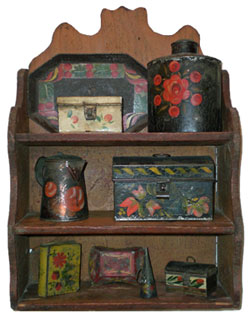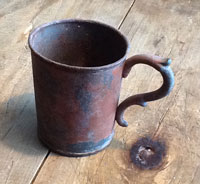|
|||
|
American Painted Tinware (aka Toleware) Painted tinware can be found in many early American collections. Commonly referred to as toleware, these pieces are made of tinned metal that has been lacquered or varnished. It can be utilitarian or decorative, but invariably bears a painted design or picture. In the 17th century, Europeans developed the technique of “japanning” items to imitate oriental lacquered objects. Since the sap from the Japanese lac tree used to make the lacquer was not available in Europe, other substances had to be used to imitate the hard shiny surface. Initially, the decorations had an Asian style as it spread across Europe. It was called tôle peinte (French for "painted sheet iron"), painted tin, or simply tole. Early English tole was painted pewter and expensive. But by the early to mid-1700s, inexpensive painted tin was being manufactured in England and shipped to the colonies.
The earliest tin was undecorated but by the late 18th century decorated tin became more common. It was initially decorated by skilled workmen trained in the techniques used abroad. Soon, however, the rural tinsmiths began to turn out a type of simply painted tin in family workshops in Connecticut, Maine, New York, and Pennsylvania. The men worked the tin and peddled it from town to town, while their wives and daughters “flowered” the finished pieces with paint. Prominent makers include the Stevens and Buckley shops near Portland, Maine; the Boynton Shop in Massachusetts; the North Shop in Otsego County, New York; and the Butler Shop in Green County, New York. Toleware forms suggest fancy display and storage. Typical pieces include trays, teapots, cheese cradles, caddies, breadboxes, and document boxes. Early toleware should show evidence of hand manufacture and hand painting or stenciling. Toleware was also produced from the 1920s to 1940s and can exhibit the same painting techniques, compositions, and color combinations as the earlier forms. Therefore, careful examination is important to determine the age of a piece. References:
|
||
|
A Tribute to Marcia’s Mom
Then Marcia shared its history. Marcia’s Mom went to a one room school house. The teacher, as a special treat, would walk around with the tin cup with penny candy in it. What makes this cup really special is that in her Mom’s adult life the one room school house burned down. In the ruins her Mom found the old tin cup. About Lyn Andeen
|
||
|
Once Again, A Collective Breath With the tragic events at the Boston Marathon earlier this month, we were once again reminded of how fragile life can be. We immediately felt connected to the events unfolding - not because we were at the finish line, or knew anyone directly effected or because we ever ran the Boston marathon. We were connected because 24 years ago, we delightfully had our son at Newton-Wellesley Hospital as the Boston Marathon runners were passing the hospital. After Josh was born, we stood at the window watching the runners! Special Offer - Less than $10/month! Have questions about opening a Shop? Just send us an email or give us a call. We'd love to have you join us! Sincerely, |
|
Search Showcase Have you been digging for antiques recently? |
|
March 2013 Top Searches Below is a summary of the twenty most popular search phrases last month.
1. windsor chair |
|
Sponsors |
|
Thank you to the following current advertisers for their support of Dig Antiques:
Baker & Co. Antiques If you are interested in supporting Dig Antiques through advertising, please click here. |
|
Contact Us |
|
For general information:
Website: www.digantiques.com |
|
© 2013 Dig Antiques. All rights reserved. |


